
1998-11-30 last update, 1996-09-15 first day, Robert Jasiek
The Ko Coupling Rules model the New Ko Rules by simplifying them. The concepts of ko coupling, ko position, and disturber are used while ko types and thus any fighting rule are omitted. Ko couplings reduce the number of ko positions on the board; not each ko mouth itself is a ko position. Between so called ko threats on the board that are not ko stones each player can become disturber only once in each ko position.
A ko mouth consists of the marked board points in any of the following shapes, in any equivalent shape, in any equivalent shape with reversed colours, or in any such shape of which a part or parts - but not any marked board point - are cut off by at least one edge of the board. In any shape diagram not marked empty points may be of empty, black, or white colour as long as no illegal position arises.








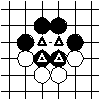
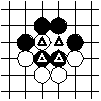

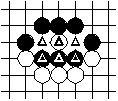

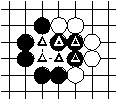
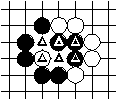
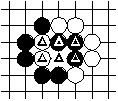
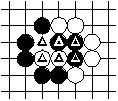
A ko string is a string in a ko mouth.
A ko stone is a stone of a ko string.
A move-sequence is a non-empty colour-alternating sequence of board plays or pass plays by both players.
A ko stone move-sequence is a move-sequence of board plays so that only ko stones are played.
Given a ko mouth and its adjacent strings. All of at least two ko mouths with all of the strings and none else being adjacent to each of the ko mouths have them as their ko coupling.
If a ko mouth is adjacent to all strings of a ko coupling and not adjacent to any other string, then the ko position of the ko mouth is the union of the board points of all ko mouths that are adjacent to all strings of the ko coupling and not adjacent to any other string. If a ko mouth is not adjacent to all strings of a ko coupling or adjacent to another string, then the board points of the ko mouth are its ko position.
A single ko stone that has captured a single ko stone may not be recaptured immediately.
During a ko stone move-sequence in a ko position a player becomes the disturber of the ko position by playing a ko stone in it first. As soon as the ko position with the stones on it has been repeated since the moment just before the occurance of the current disturber, he is not allowed to play a ko stone in the ko position. With the end of the ko stone move-sequence in the ko position a disturber ceases to exist. If the disturber is not allowed to play a ko stone in the ko position and the ko stone move-sequence in the ko position continues, then the disturber ceases to exist and the other player becomes the disturber.
From all board positions with the same set of board points of all ko positions and with the same configuration of stones on the board without the set each player may only once become disturber of each ko position or otherwise play a stone on each board point.